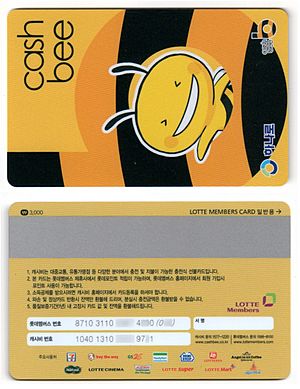Smart card facts for kids
A smart card is like a small computer in a card. It has a tiny microchip built right into it. These special cards are used to help identify people or to check if someone is allowed to do something, like making a payment or getting into a building.
Many plastic cards you use today, like those for taking out money from an automated teller machine (ATM), are smart cards. Some older cards might still have a magnetic stripe, but smart cards use the chip for more security. When you use one, you often need to enter a secret number called a PIN. If you type the PIN correctly, you can use the card. If you try too many times with the wrong PIN, the card might get blocked to keep your money safe.
Smart cards first appeared in France in 1983. They were used in public telephones to store pre-paid credit for calls. As you made calls, the credit on the card would go down. Today, some services store your balance in a central computer system instead of on the card itself. This means you don't always need a card with a chip for certain things. Smart cards are also very popular for making payments, especially in places like Japan, Singapore, and with the Octopus card in Hong Kong.
Contents
How Smart Cards Work
Smart cards are pretty clever! They work by using the small microchip inside them. This chip can store information and even do some basic calculations. When you use a smart card, it communicates with a special reader. This reader helps the card do its job, whether it's checking your identity or processing a payment.
Different Kinds of Smart Cards
There are two main types of smart cards, each with its own way of working:
- Simple Memory Cards: These cards are like a small digital notebook. They only have memory to store information. They can be read from and written to, but they don't do any complex thinking themselves. All the heavy work of processing the data is done by an outside computer or machine. Examples include old phone cards or some health insurance cards.
- Complex Microchip Cards: These are more advanced. Besides storing data, they have a tiny computer chip that can actually process information. This means they can do more than just hold data; they can also help secure it. You usually can't directly access the memory on these cards. Bank cards used for withdrawing money and SIM cards in mobile phones are good examples of these smart cards. Both types of cards have a special part that helps them talk to other devices.
Contactless Smart Cards
Many modern smart cards use a cool technology called RFID. This lets you use the card without actually putting it into a machine. You just need to hold it close to a special reader. These are called "contactless smart cards." Lots of credit and debit cards today are contactless, making payments super fast and easy!
Images for kids
-
One of the first smart card prototypes, created by its inventor Roland Moreno around 1975. The chip has not yet been miniaturized. On this prototype, one can see how each pin of the microchip (center) is connected to the exterior world by a copper connector.
-
Contact-type smart cards may have many different contact pad layouts, such as these SIMs.
-
A false smart card, with two 8-bit CMOS microcontrollers, used in the 1990s to decode the signals of Sky Television.
See also
 In Spanish: Tarjeta inteligente para niños
In Spanish: Tarjeta inteligente para niños











